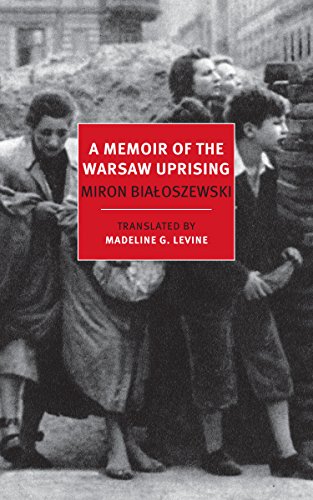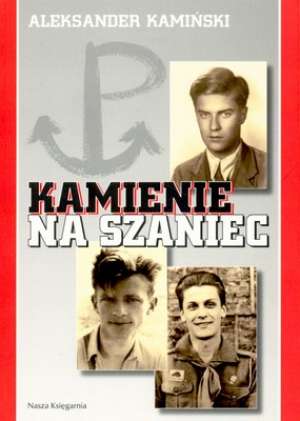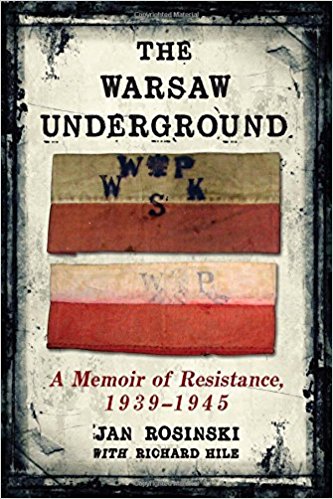Great books about Warsaw Uprising Posted by Kasia on Aug 3, 2017 in Culture, History
The Warsaw Uprising (Powsanie Warszawskie) lasted from August 1944 to October 1944. Fueled with hope as a result of the rapidly advancing Russian Army, The Polish Underground Home Army decided to take on the might of the Germans in the Poland. Not unnaturally, they felt that their efforts would be helped by the Russians. Units from the Polish Home Army took on the Germans at Vilnynus, Lublin and Lvov. While the Russians attacked from the east, the Poles fought German forces to the west, effectively squeezing the German Army. In all three cities they gave the Russians valuable help. Buoyed by this success, the Home Army decided to do the same in Warsaw. However, here different circumstances occurred which were to have dire consequences for the uprising. The Germans had decided to make Warsaw a fortress city which would be defended at all costs in an effort to stem the advance of the Red Army.
General ‘Bor’ Komorowski had decided that the uprising would start at 05.00 on August 1st. He had about 40,000 soldiers at his disposal but only 2,500 had weapons. They faced a German force in the city that numbered 15,000 men. However, there were 30,000 German troops in the immediate vicinity of the city. Unlike the Polish Home Army, the Germans had tanks, planes and artillery at their disposal. Many were also battle-hardened troops from the Hermann Goering SS Panzer and Paratroop Division and the SS ‘Viking’ Panzer Division. They were in and near Warsaw to defend it against the Red Army. Therefore, when they found that they were needed to fight the Home Army, they were in no mood to be merciful.
The Warsaw Uprising of 1944 — a heroic and tragic 63-day struggle to liberate World War 2 Warsaw from Nazi/German occupation. Undertaken by the Home Army (Armia Krajowa, AK), the Polish resistance movement, at the time Allied troops were breaking through the Normandy defenses and the Red Army was standing at the line of the Vistula River. Warsaw could have been one of the first European capitals liberated; however, various military and political miscalculations, as well as global politics — played among Joseph Stalin, Winston Churchill and Franklin D. Roosevelt (FDR) — turned the dice against it.
There are many amazing books about Warsaw Uprising. Here are few of them:
“A Memoir of the Warsaw Uprising” by Miron Białoszewski
Białoszewski’s blow-by-blow account of the uprising brings it alive in all its desperate urgency. Here we are in the shoes of a young man slipping back and forth under German fire, dodging sniper bullets, collapsing with exhaustion, rescuing the wounded, burying the dead. An indispensable and unforgettable act of witness, A Memoir of the Warsaw Uprising is also a major work of literature. Białoszewski writes in short, stabbing, splintered, breathless sentences attuned to “the glaring identity of ‘now.’” His pages are full of a white-knuckled poetry that resists the very destruction it records.
Kamienie na szaniec (lit. Stones for the Rampart, also translated as Stones on the Barricade) by Aleksander Kamiński
It is a 1943 non-fiction novelby Polish writer Aleksander Kamiński. Published by the Polish underground press during the World War II occupation of Poland, the book describes the acts of sabotage and armed resistance carried out by the Polish underground scout movement, the Gray Ranks, of whom Kamiński was one of the instructors and leaders.
The story portrayed in the book is a slightly fictionalized account of real lives of Gray Rank members (known by their noms-de-guerre of “Rudy”, “Zośka”, and “Alek”), with the final act centred on the Operation Arsenal. The book tells the story of a group of Polish boy-scouts trying to rescue “Rudy” from the Gestapo captivity. While they succeed in freeing their friend, he has sustained grave injuries from torture during German interrogations, and dies shortly afterwards. “Alek” and “Zośka” also die shortly afterwards: the former from wounds sustained during the rescue, while “Zośka” is killed in another operation. Like stones thrown by God upon a great rampart – “Jak kamienie przez Boga rzucane na szaniec”. They met and became friends in the Stefan Batory middle school at the 23rd Warsaw Scouting Team Pomarańczarnia (Orangerie – the name was chosen because of their scarves’ colour), during a holiday in the mountains. After passing their high-school graduation exams, they were to begin university studies which was – at least officially – prevented by the beginning of World War II. As active scouts they swore an oath to the ‘Grey Ranks’ – a secret organization of the youngest volunteers that was a part of the underground structures fighting occupation.
Already immensely popular during World War II, after the war the book entered the canon of Polish literature and remains a recommended reading text for Polish students in the secondary school curriculum.
“The Warsaw Underground: A Memoir of Resistance, 1939-1945” by Jan Rosiński, Richard Hile
The German invasion of Poland in September 1939 abruptly ended author Jan Rosiński’s student life, and propelled him into an activist role in the Polish resistance organization Armia Krajowa. In short order he became a talented forger of Nazi documents, especially travel papers that allowed many refugees to escape the city. His university studies in chemistry and physics created a role for him as an effective saboteur. Narrowly escaping death on several occasions, he was fearless in his pursuits. His dislike of the Nazi leadership was exceeded by an even greater hatred of the Soviet Army as it invaded Poland from the East less than a month later. Poland would be sealed off from the West for fifty years. Rosiński’s travails as a POW in Germany eventually led him to the Allied forces in Germany; the U.S. became the beneficiary of his brilliant discoveries in atmospheric science. Jan was accompanied on his life’s journey by his wife Barbara (d. 1993), who served as a medical officer in the underground army; Jan died in 2012.
There are many, many more. These 3 are definitely my favorites!

Build vocabulary, practice pronunciation, and more with Transparent Language Online. Available anytime, anywhere, on any device.






